If you love someone who hoards, you’ve probably asked yourself, “Why can’t they just throw this stuff away?” It’s frustrating. It can feel like your loved one is choosing things over their own safety or happiness. But the truth is, hoarding isn’t just about being messy. It’s often related to a mental health disorder.
Behind the piles of stuff, there’s often a lot of pain. Your loved one might be struggling with anxiety, depression, trauma, or deep feelings of fear. The clutter you see is only part of the story. This Mental Health Awareness Month, let’s talk about what’s really going on—and how you can help.
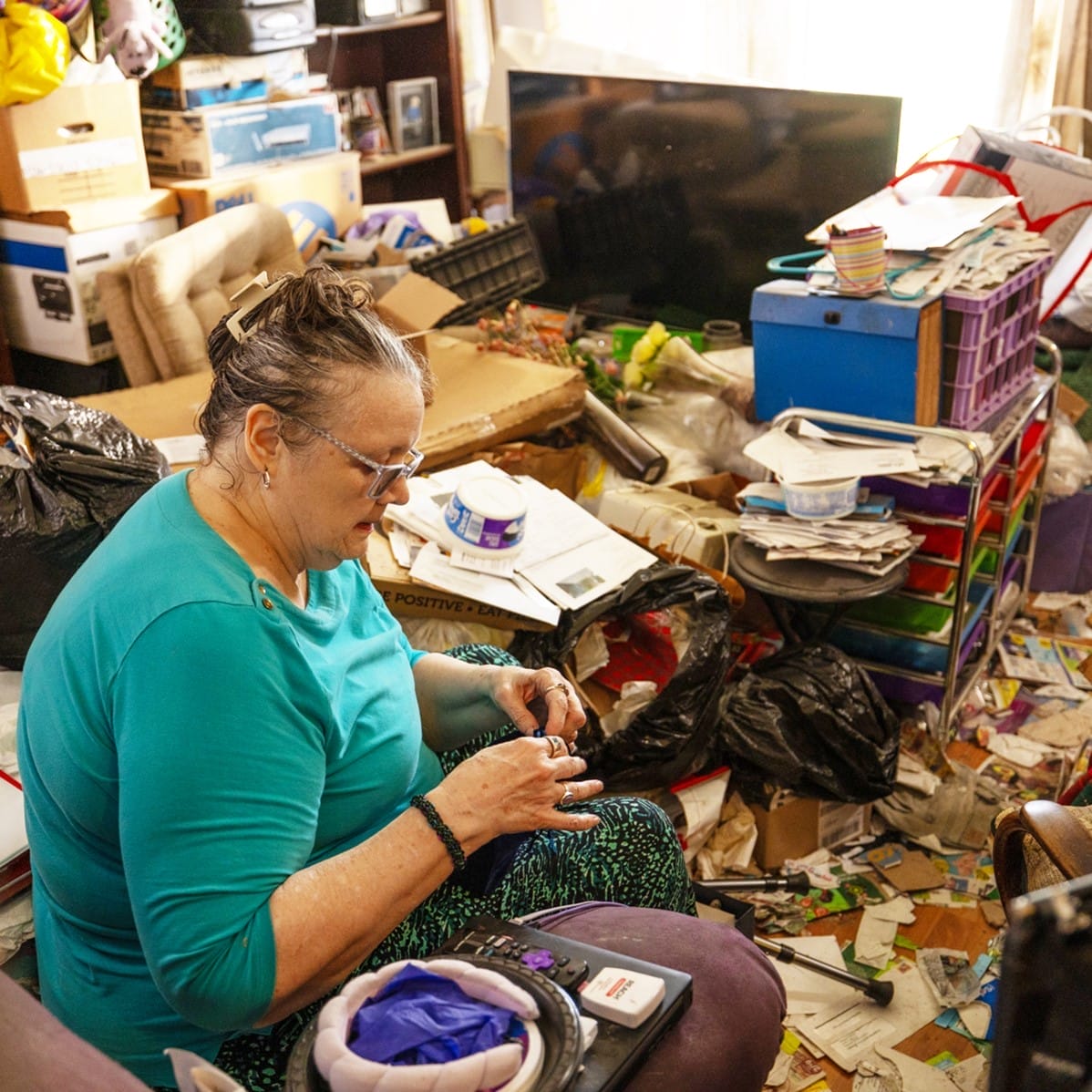
Hoarding disorder is when someone has a very hard time getting rid of things, even items that seem useless or broken. They feel a strong need to keep things, and just thinking about letting go can cause panic or sadness.
It’s not about laziness. It’s not about being dirty. It’s about how the brain is trying to protect itself. For many people, keeping things feels like a way to stay safe or in control, especially if they’ve been through something hard in life.
Signs of hoarding disorder might include:
When someone you love is living in a home filled with clutter, your first thought might be, “I’ve got to fix this.” You might want to step in, start tossing things, or give them an ultimatum. After all, you care about them and you’re scared for their safety.
But here’s the hard truth: Confronting someone with a hoarding disorder in a harsh or forceful way almost never works. In fact, it can make the problem worse. Hoarding is deeply emotional.
If a person feels judged, cornered, or forced to let go of their things, they may shut down entirely or hold on even tighter.
You’re not alone in feeling overwhelmed. But there’s a better way to help.
Here’s what works better:
When you lead with love instead of force, you build trust, which opens the door to real change.
Progress might come slowly, but every step made with patience and compassion is a step in the right direction.
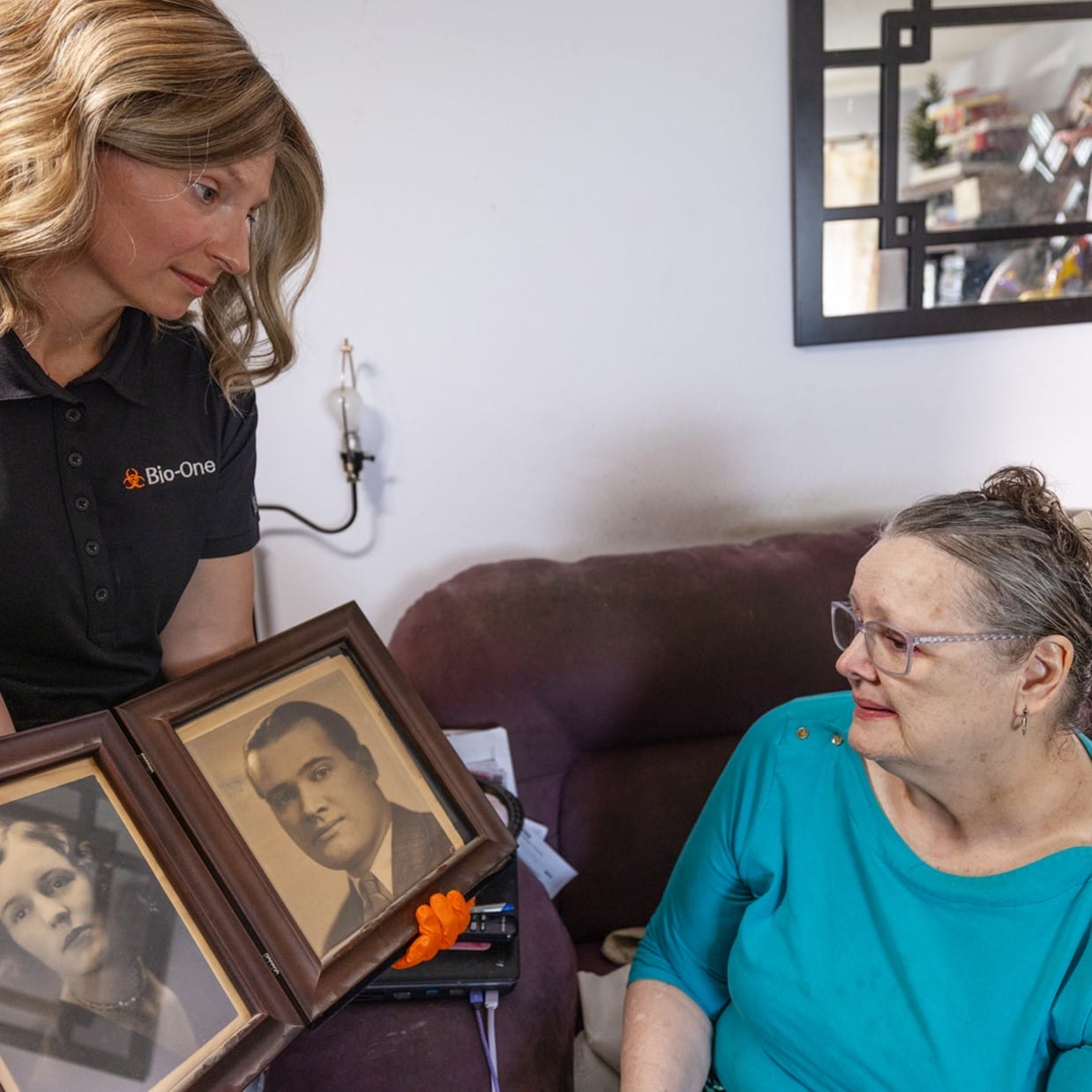
Loving someone with a hoarding disorder isn’t easy. You may feel tired, angry, confused, or even hopeless. You might be trying to help while also juggling work, family, and your own emotions. It’s a lot to carry.
You care deeply, and that’s why you’re here, trying to learn more. But you also need care. Your feelings matter, too.
So many people are in the same situation—quietly worrying about a parent, sibling, spouse, or friend struggling. It can feel isolating, especially if others don’t understand. That’s why it’s important to reach out and get support for yourself, not just for your loved one.
Here are some ways to take care of yourself:
At Bio-One, we’ve seen how tough this road can be for families. That’s why we show up with compassion, not judgment, for your loved one, and for you.
You’re not failing. You’re not alone. You’re doing your best. And that’s enough.
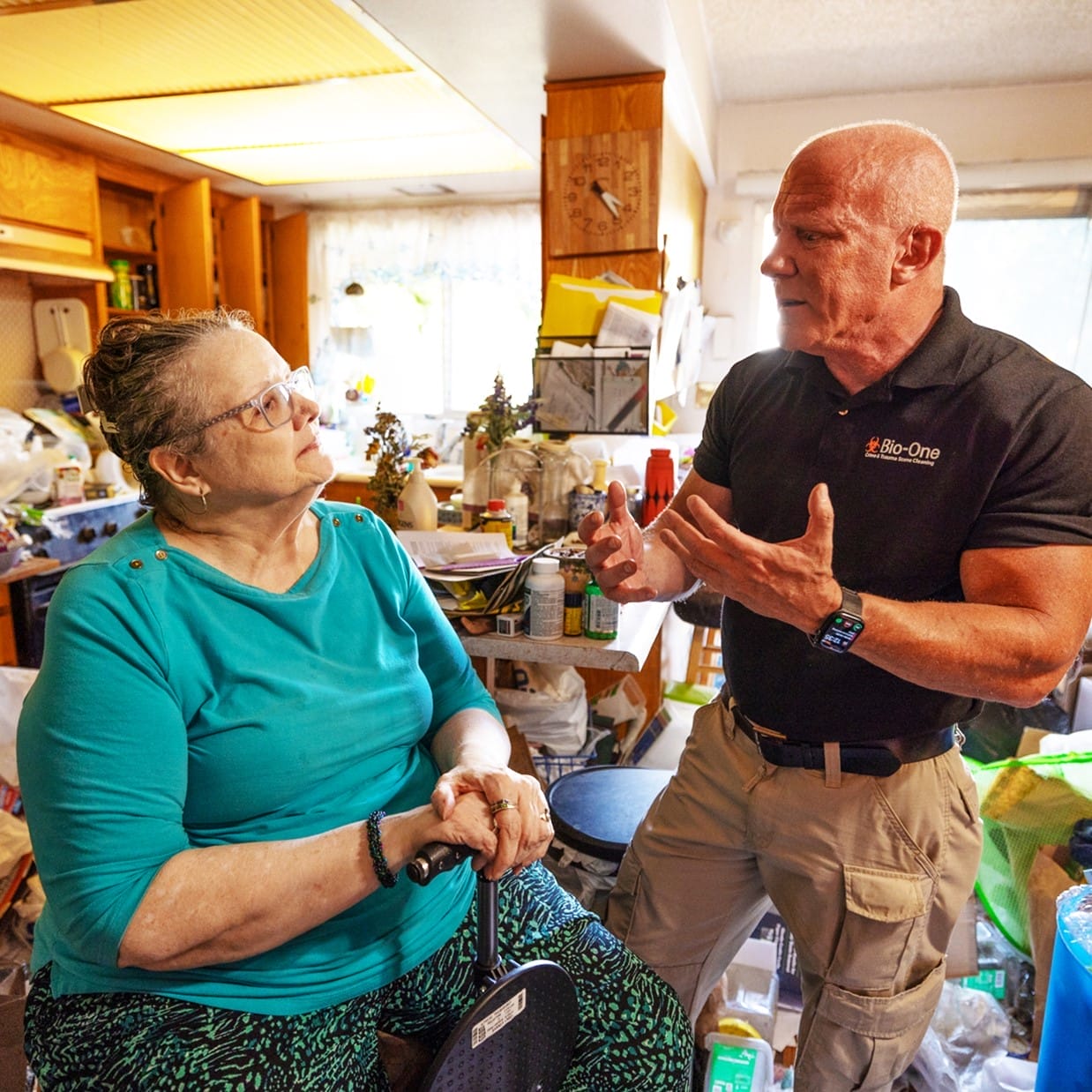
Sometimes, the situation is too big to handle by yourself. That’s where we come in.
At Bio-One of Towson, we’ve helped thousands of families just like yours. Our trained technicians know how to clean cluttered homes with care and compassion. We don’t judge. We listen, we understand, and we’re here to help.
We work gently and respectfully to make the space safer and more comfortable. And we involve your loved one every step of the way, so they feel more in control and less afraid.
If someone you love has a hoarding disorder, it can feel overwhelming. But with time, support, and understanding, things can get better.
Progress doesn’t happen all at once. But each kind word, each small step, and each moment of support makes a big difference.
And when you need help, we’re here.
How to Help a Loved One With a Hoarding Disorder
Why Cleaning a Hoarding Mess is a Job for a Professional Hoarding Cleanup Service
Hoarding: Recognizing the Signs and Seeking Help. Finding hope and motivationto clean up your home.
Hoarding disorder is a mental health condition where a person has a very hard time getting rid of things. They often feel strong emotional attachments to items and may become overwhelmed or upset when asked to let them go.
No. Hoarding is not the same as being messy or disorganized. It’s a mental health struggle that usually involves deep emotions like fear, anxiety, or past trauma.
For someone with a hoarding disorder, letting go of items can feel scary or painful. What might look like trash to others might feel safe or important to them. Cleaning without their consent can cause stress or damage trust.
Start with kindness and concern. Use “I” statements like “I’m worried about your safety,” and avoid blaming. Focus on how you can support them instead of trying to take control.
This is common. Hoarding can bring up strong feelings. Try to stay calm and patient. Don’t push too hard. Give them time, space, and support. It may help to talk with a counselor or mental health professional for guidance.
No. Throwing items away without permission can break trust and make the situation worse. It’s important to involve your loved one in every step and help them feel safe and respected.
Helping someone with a hoarding disorder can be exhausting. Make time for yourself, set healthy boundaries, talk to a trusted friend, and consider joining a support group. You matter too.
Yes. Many people with hoarding disorder can improve with the right kind of help. Therapy, support from loved ones, and professional cleanup services that understand the emotional side of hoarding can all make a big difference.
If the clutter is unsafe, overwhelming, or beyond what you can manage, it’s time to call in trained professionals. At Bio-One, we approach each cleanup with care, compassion, and respect for your loved one.
Yes. We understand how emotional hoarding can be. Our goal is to make the space safer and more livable while treating everyone involved with dignity. We don’t judge. We’re here to help.
Introduction:
In the wake of a suicide, the emotional toll on loved ones is immeasurable, compounded by the daunting task of cleanup. Amidst the urban landscape of Baltimore City, Bio-One of Towson stands as a beacon of compassion and expertise, offering essential support to families and communities grappling with loss. In this blog, we explore the invaluable role of Bio-One of Towson's suicide cleanup services in Baltimore City, MD, and how they provide solace and restoration during life's darkest moments.
A Trusted Partner in Tragedy:
Bio-One of Towson is more than just a cleanup company; it's a dedicated ally for those navigating the aftermath of suicide. With a team of compassionate professionals trained in biohazard remediation and trauma scene cleanup, Bio-One of Towson approaches each situation with empathy, discretion, and unwavering support. Their mission is to ease the burden on survivors while restoring safety and dignity to the affected space.
Comprehensive Services:
Bio-One of Towson's suicide cleanup services in Baltimore City, MD, encompass a comprehensive range of specialized tasks designed to address the unique challenges of each situation. These services include:
The Human Touch:
What sets Bio-One of Towson apart is their unwavering commitment to compassionate care. Beyond the technical aspects of cleanup, their team understands the profound impact of loss and trauma on individuals and communities. They offer a compassionate presence, a listening ear, and a shoulder to lean on during the darkest moments, guiding survivors through the healing process with empathy and understanding.
Conclusion:
In Baltimore City, MD, Bio-One of Towson's suicide cleanup services serve as a beacon of hope and healing for those affected by tragedy. With their expertise, compassion, and unwavering support, they offer solace amidst the pain, restoring safety, dignity, and peace of mind to survivors. In their dedication to service, Bio-One of Towson exemplifies the power of compassion to transform lives and communities, proving that even in the face of darkness, there is light and restoration.
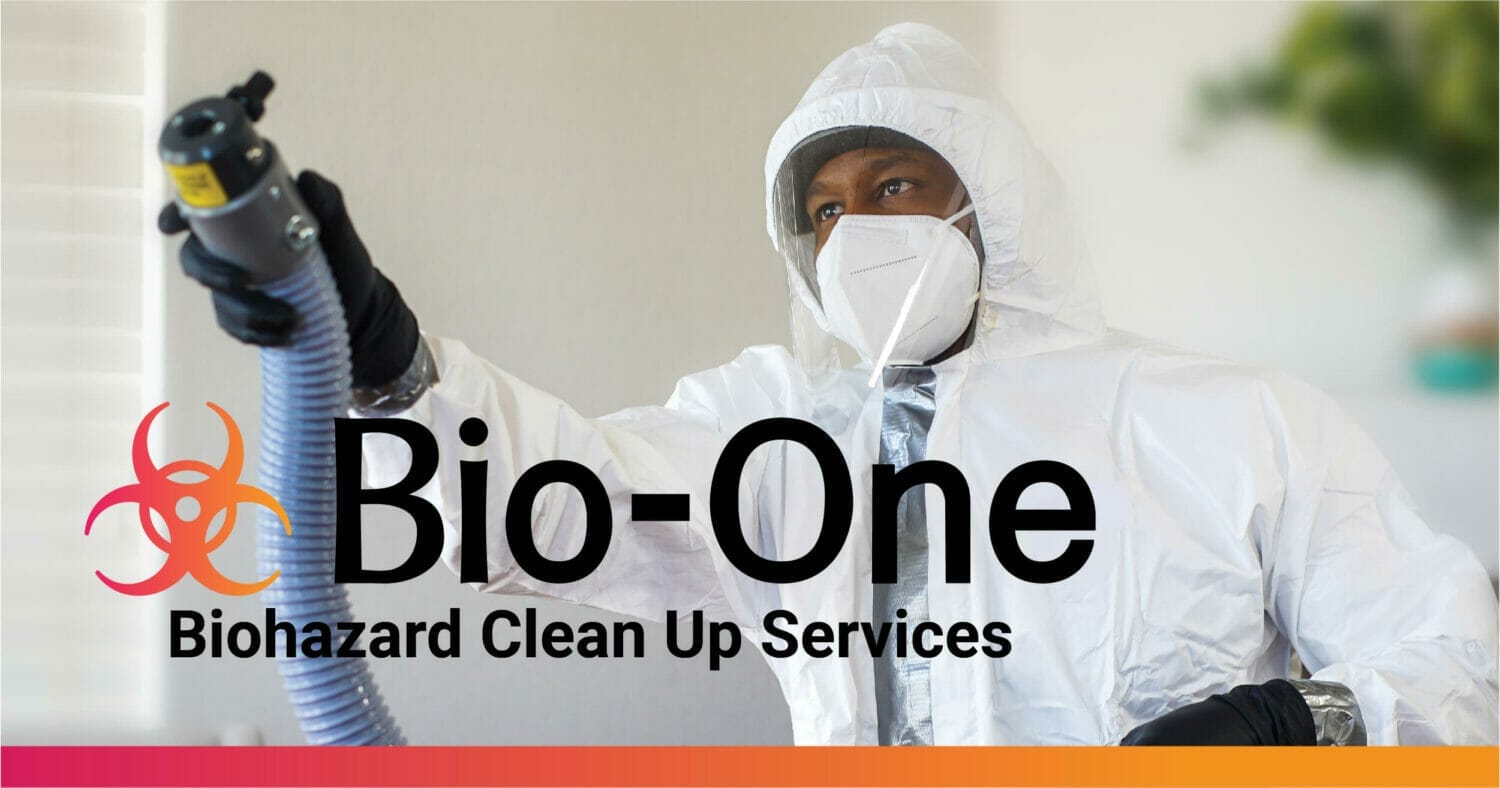
In Towson, Maryland, a serene suburb just north of Baltimore, life unfolds much like it does in any other American community. However, amidst the tranquility, there are moments that remind us of life's fragility and the need for compassionate support during challenging times. One such occasion is the cleanup following a death, a task that demands sensitivity, professionalism, and expertise. In this blog, we'll explore the vital role of death cleanup services in Towson, MD, and how they provide crucial assistance to families and communities in their darkest hours.
Understanding Death Cleanup:
Dealing with the aftermath of a death is an emotionally overwhelming experience. Whether it's due to natural causes, accidents, or acts of violence, the cleanup process requires specialized knowledge and equipment to address biohazards, bodily fluids, and decomposition. This is where death cleanup services step in, offering thorough and discreet cleaning solutions to restore affected spaces to a safe and habitable condition.
The Importance of Professional Assistance:
Attempting to handle death cleanup without professional help not only poses health risks but also prolongs the emotional distress for loved ones. Professional death cleanup technicians in Towson, MD, are trained to approach each situation with empathy and respect, understanding the sensitive nature of their work. They adhere to strict protocols and regulations to ensure thorough decontamination while minimizing further trauma to those affected.
Services Offered:
Death cleanup services in Towson, MD, encompass a range of specialized tasks tailored to each unique situation. These may include:
The Role of Compassion:
Beyond the technical aspects of their work, death cleanup professionals in Towson, MD, recognize the importance of compassion in their interactions with clients. They understand that grieving families and individuals are navigating profound loss and trauma, and they strive to provide a supportive presence throughout the cleanup process. Their goal is not only to restore physical spaces but also to offer a measure of comfort and reassurance during a challenging time.
Conclusion:
In Towson, MD, death cleanup services play a vital role in helping families and communities navigate the aftermath of loss with dignity and compassion. By providing expert cleaning solutions and unwavering support, these professionals offer a glimmer of hope amidst the darkness, restoring order to disrupted lives and spaces. In their commitment to service, they exemplify the resilience and compassion that define the human spirit in the face of adversity.


There are varied reasons people hang on to things they don’t need based on their circumstances or deeper-lying struggles. A cluttered home—even one that would qualify as a Level 5 situation—doesn’t stem from laziness or lack of willpower.
More often than not, a cluttered home is the result of a difficult-to-control situation, which is part of normal life.
What’s the source of your clutter? Following, are a few factors that may be contributing to your at-home clutter:

Having children can bring an abundance of joy, but also plenty of clutter.
Baby gear that is only used for a short period of time, rapidly changing clothes sizes, and piles of toys accumulate quickly.
It doesn’t end with the baby phase, though. As all guardians know, older kids and teens bring their own messes into the home.
Food-related messes combined with sleep deprivation can make it difficult to keep up with housework.
With children leaving clutter everywhere and food-related messes needing immediate care, it can be difficult to keep up with housework. Especially when you consider the sleep deprivation that also comes with kids.
Between art and science projects on the counter and smelly gym bags and laundry
left around the house, things can get (or stay!) messy.
It doesn’t help that children aren’t well-known for cleaning up after themselves!
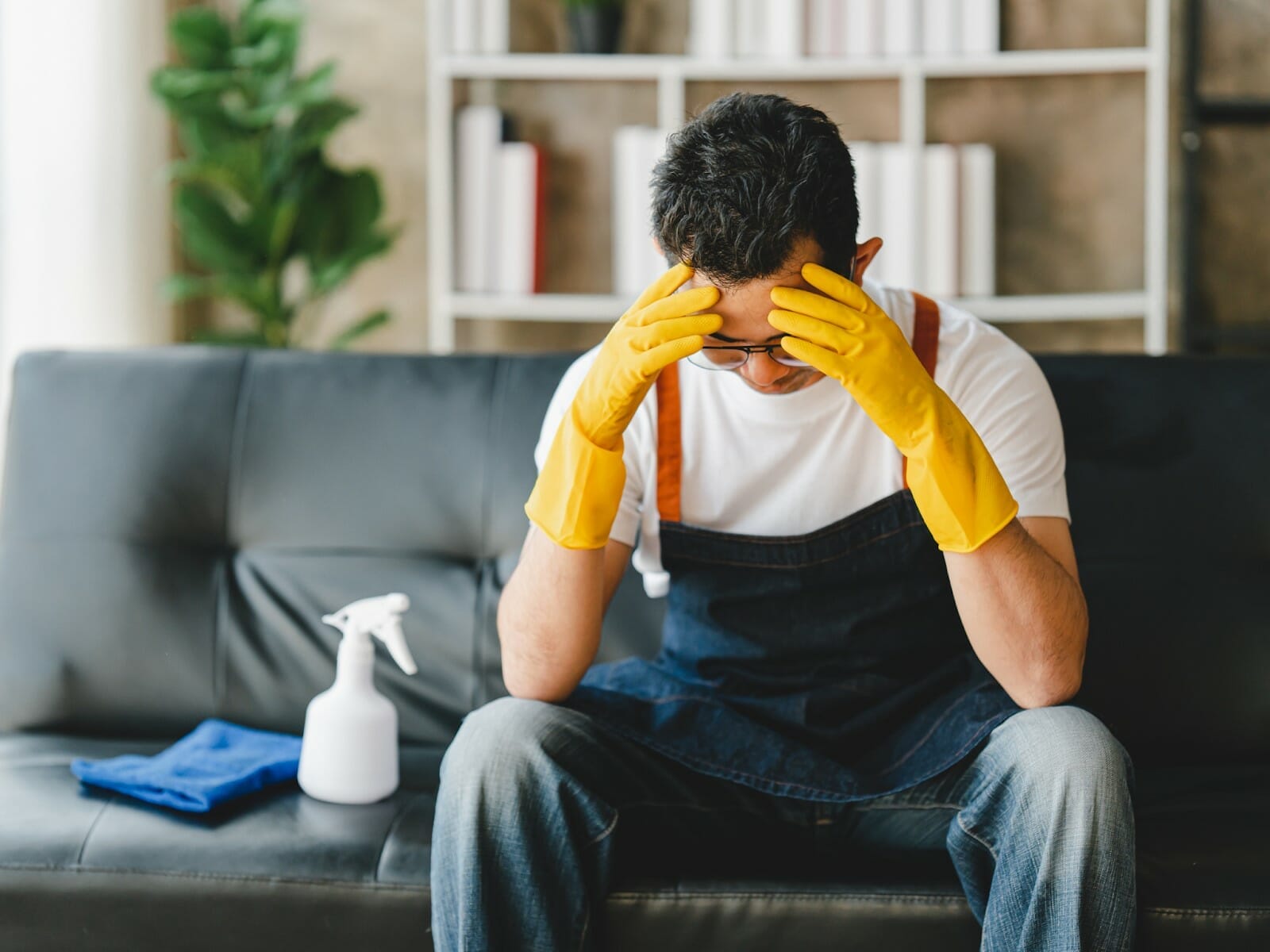
As adults age, they may struggle to keep up with their housework.
Think of all the reaching and bending over. Consider all the hard scrubbing. With health issues, simple cleaning tasks take much longer to accomplish, if it can still be done.
Decreased mobility and increased health issues can make cleaning overwhelming or even impossible.
In addition, it can be difficult to let go of possessions accumulated over a lifetime.
Anxiety can make it difficult to throw away possessions.
People with anxiety may hold on to items in excess in case of a feared emergency or indecision about what to do with items.
Finding the motivation to clean and declutter is often a struggle for someone suffering from depression.
The stress of an out-of-control home situation (whether it’s actually out of control
or simply perceived to be) can create a negative feedback loop.
For example, maybe you’re struggling with depression and lack the motivation to do the dishes. This means the dishes quickly pile up and within a week or two every surface in your kitchen could be covered in dirty dishes.
Now, you’re facing an overwhelming mess that can make you feel even worse—piling on exhaustion, guilt, and shame—and making you even less likely to find the motivation to clean up.
This cycle can leave those struggling with depression feeling more overwhelmed and less able to approach their home situation.
Individuals with ADHD often have intense, passionate interests and may accumulate items related to that interest. In addition, it can be difficult for a person with ADHD to create and stay focused on a plan for a big cleaning project. Anytime there are multiple steps involved, it’s easy for people with ADHD to get distracted.
Obsessive-compulsive disorder is characterized by obsessive, intrusive thoughts and compulsive behaviors. People with OCD sometimes deal with anxieties and emergencies by compulsively buying items. They may have obsessions about running out of essential items or a buying ritual that is difficult to break out of.

Trauma can be a trigger for accumulating clutter. If someone grew up without:
They may feel driven to hold onto things rather than throw them away when they are no longer needed. Research shows that childhood emotional abuse and physical neglect in particular predict higher levels of hoarding symptoms.
People who have experienced loss may also accumulate possessions to soothe the ache of missing their loved one. Buying new things triggers a brief dopamine high, bringing temporary emotional relief.
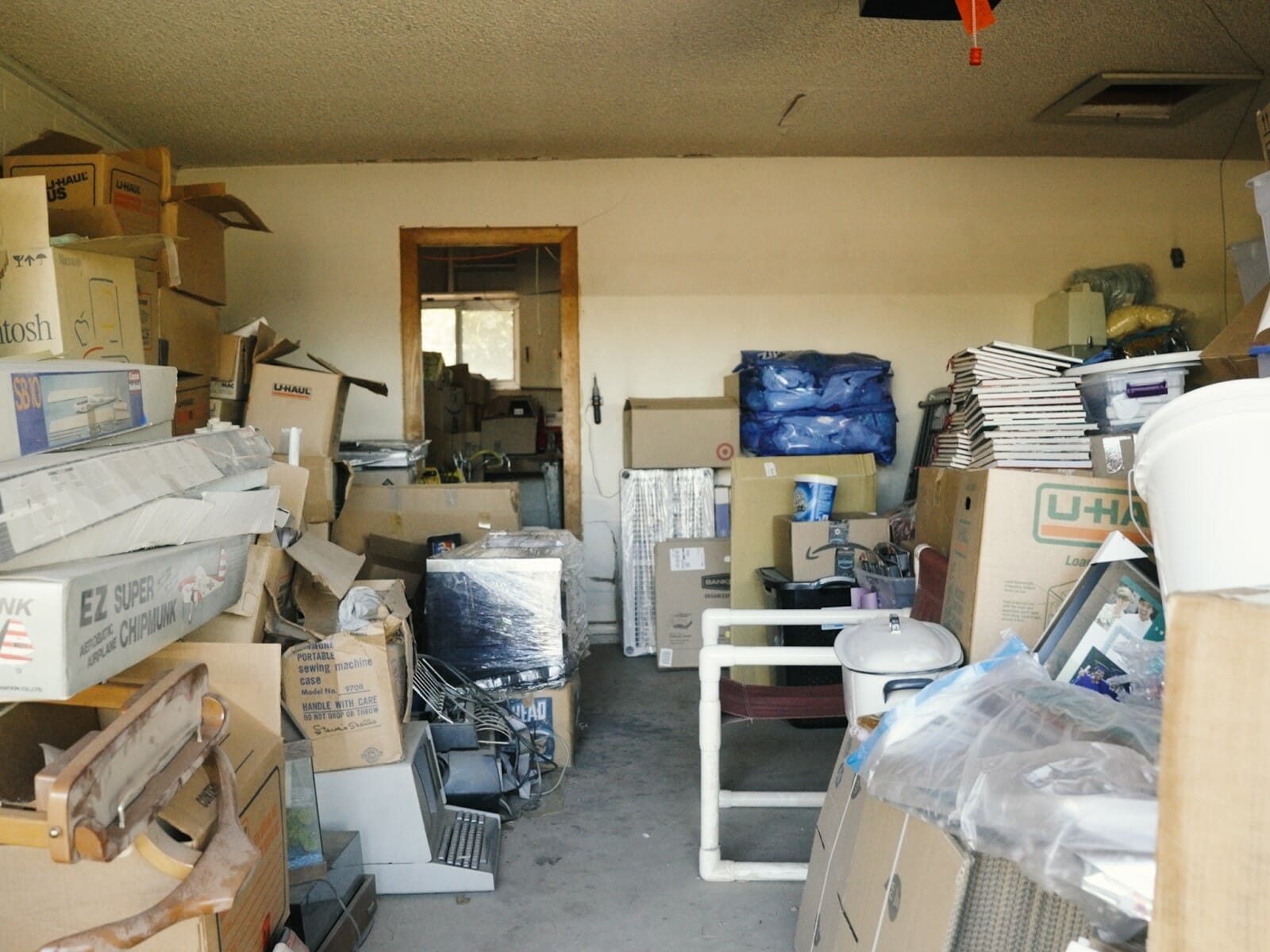
If you grew up in a home where clutter was common, you are more likely to show these behaviors yourself. You may have a genetic disposition toward it through related diagnoses like anxiety or depression. You may also be more used to an environment where clutter, mess, and even the higher levels of hoarding are the norm.

No matter the reason clutter starts, it’s normal to feel overwhelmed and stressed by the situation. Home maintenance is a big task under any conditions. Certain factors can make the situation feel impossible such as:
Stress can lead to disorganized homes, and disorganized homes can increase stress. Natalie Christine Dattilo, PhD, clinical health psychologist and instructor of psychiatry at Harvard Medical School, calls it a chicken-or-egg dilemma.
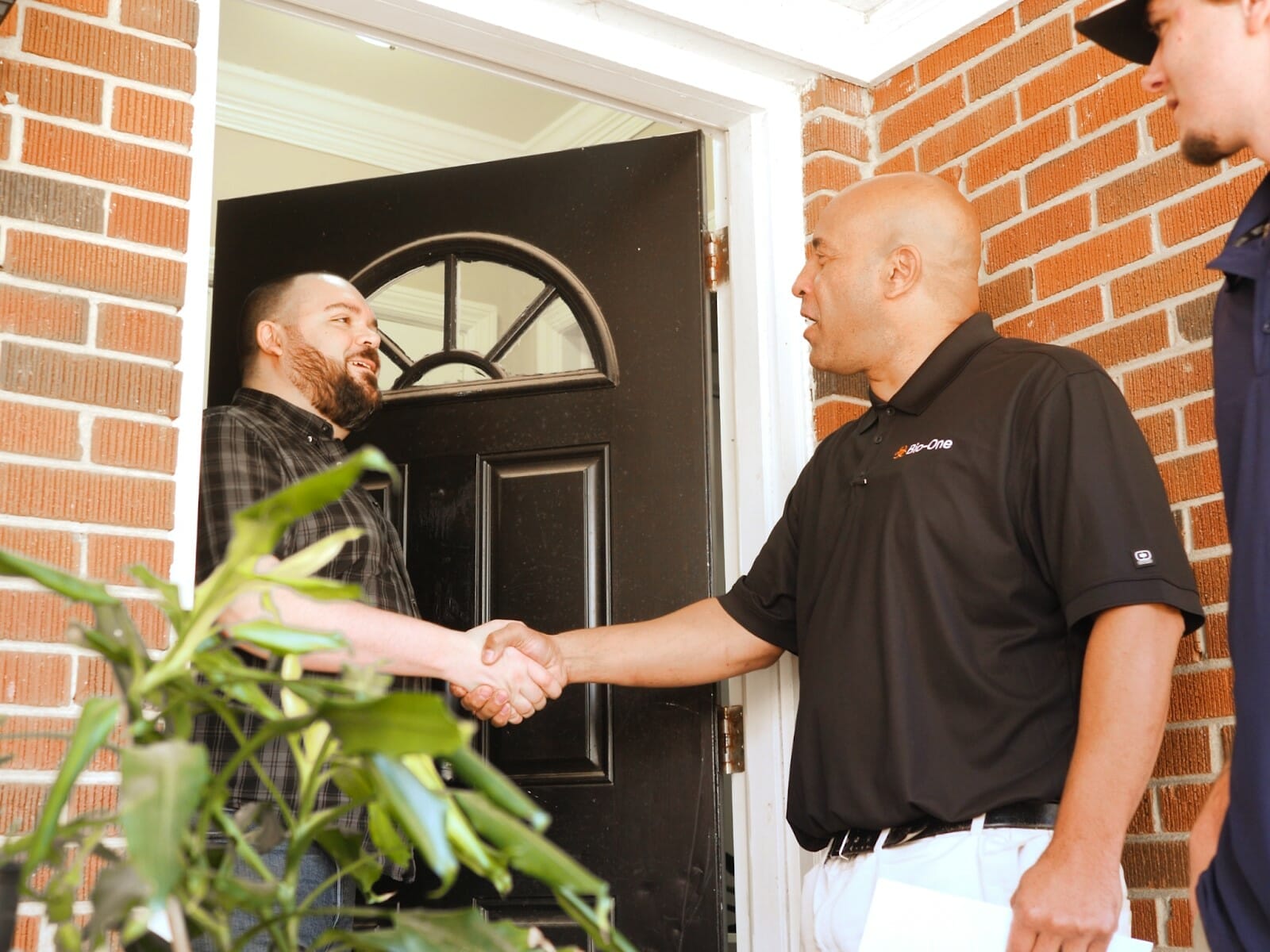
“Recent studies have shown that clutter in our homes is associated with higher cortisol levels [our stress hormone], but it’s still unclear which comes first,” says Dattilo.
“Is it that when we are under stress, our ability to maintain a well-organized home becomes impaired? Or when our home is in disarray, does that make us feel more stressed, overwhelmed, and anxious?”
Regardless of the root of the issue, there is a way out. Resources are available to help you deal with your home situation. Bio-One can help! Our services can help ease your stress. For more information on how we can help you with your clutter call (443) 846-2323.
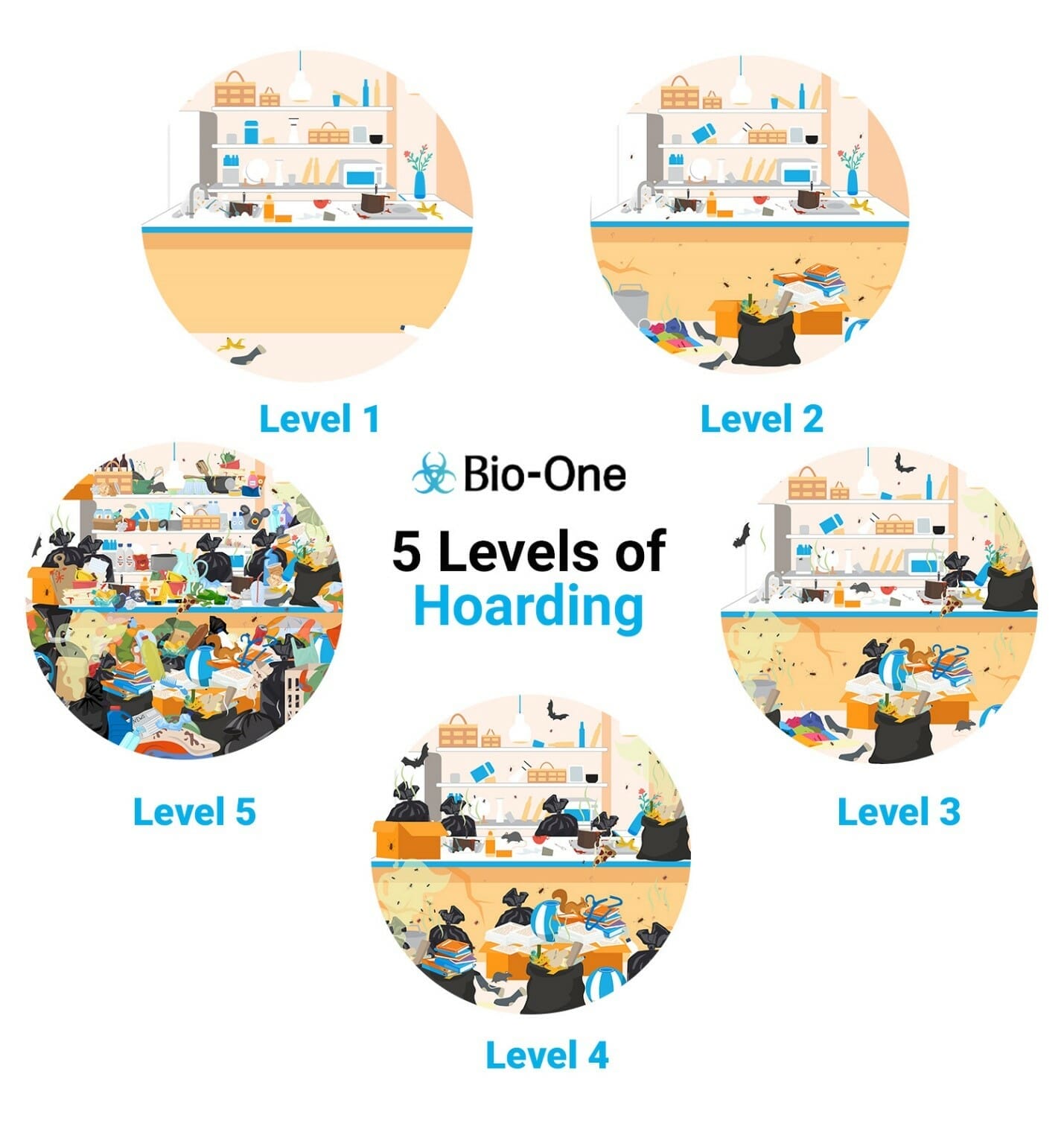
The word “hoarding” probably evokes a particular image, made more common by shows like Hoarders that highlight extreme examples. In reality, not all hoarders have rooms full of items piled high to the ceiling.
The Institute for Challenging Disorganization (now, there’s a relatable title!) has classified hoarding behavior into five levels on their Clutter-Hoarding Scale.Level 1 Hoarding
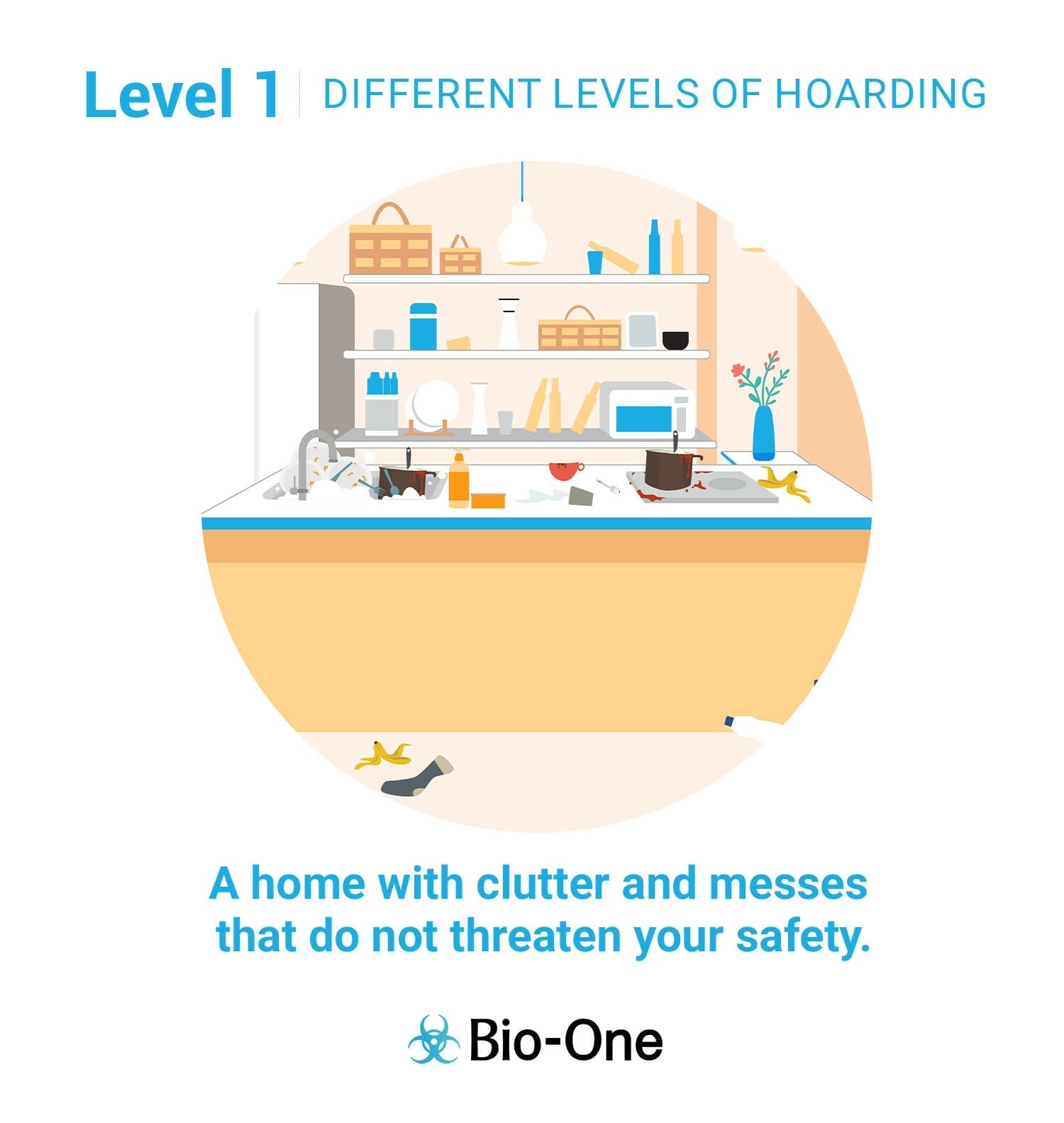
At Level 1, a home is not pristine, but the space is still easily accessible and sanitary. There is clutter, but no concern for safety. Most, if not all of us, have been in Level 1. Many people spend most of their time in this stage.
Here are the defining characteristics of this level:
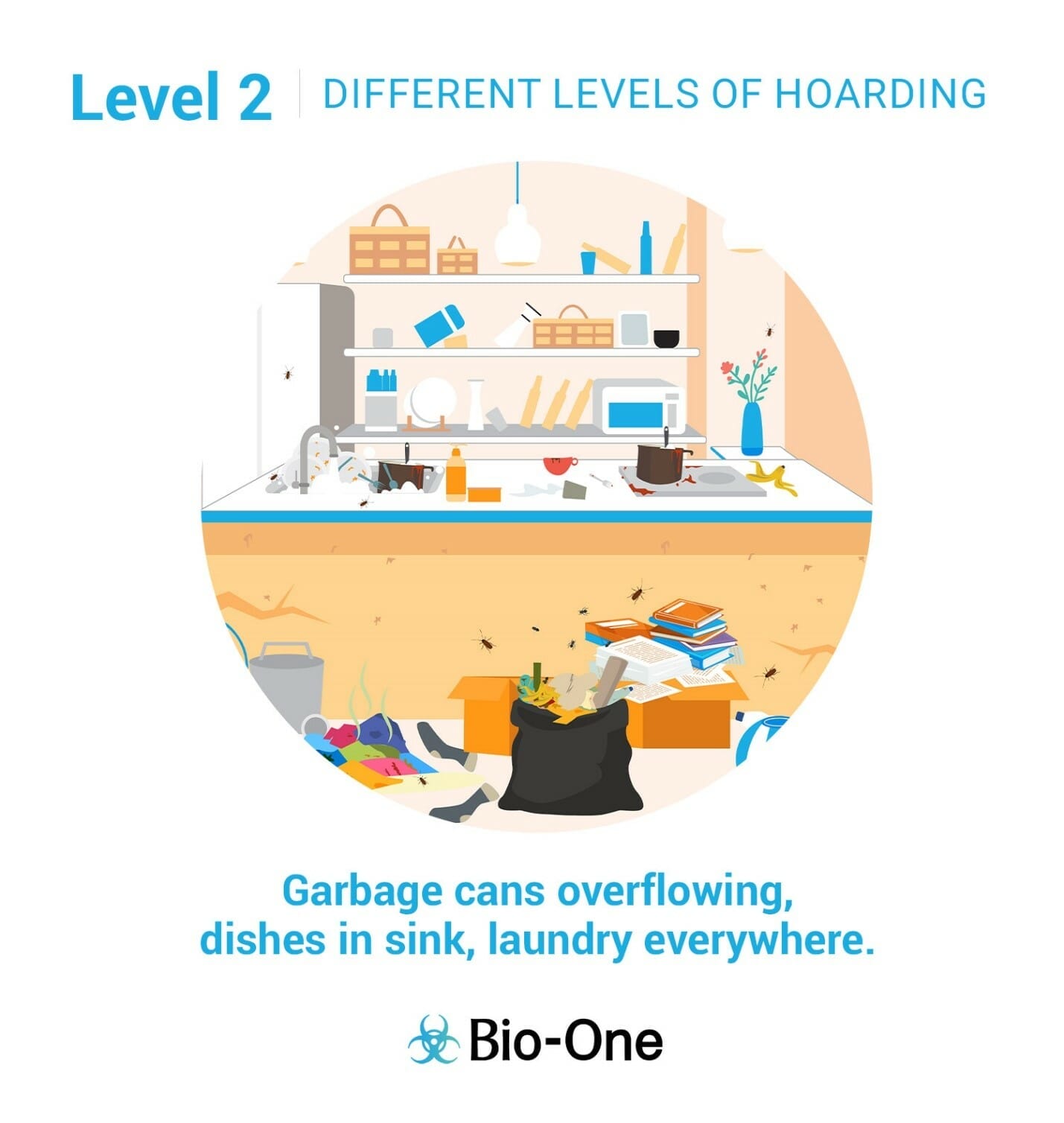
At Level 2, the home is still very livable, but there’s more evidence of disarray. The home is in need of cleaning and may be starting to overwhelm the residents. The hygiene level isn’t optimal.
Most of us bounce between Level 1 and Level 2. However, here are the more defining characteristics of Level 2:
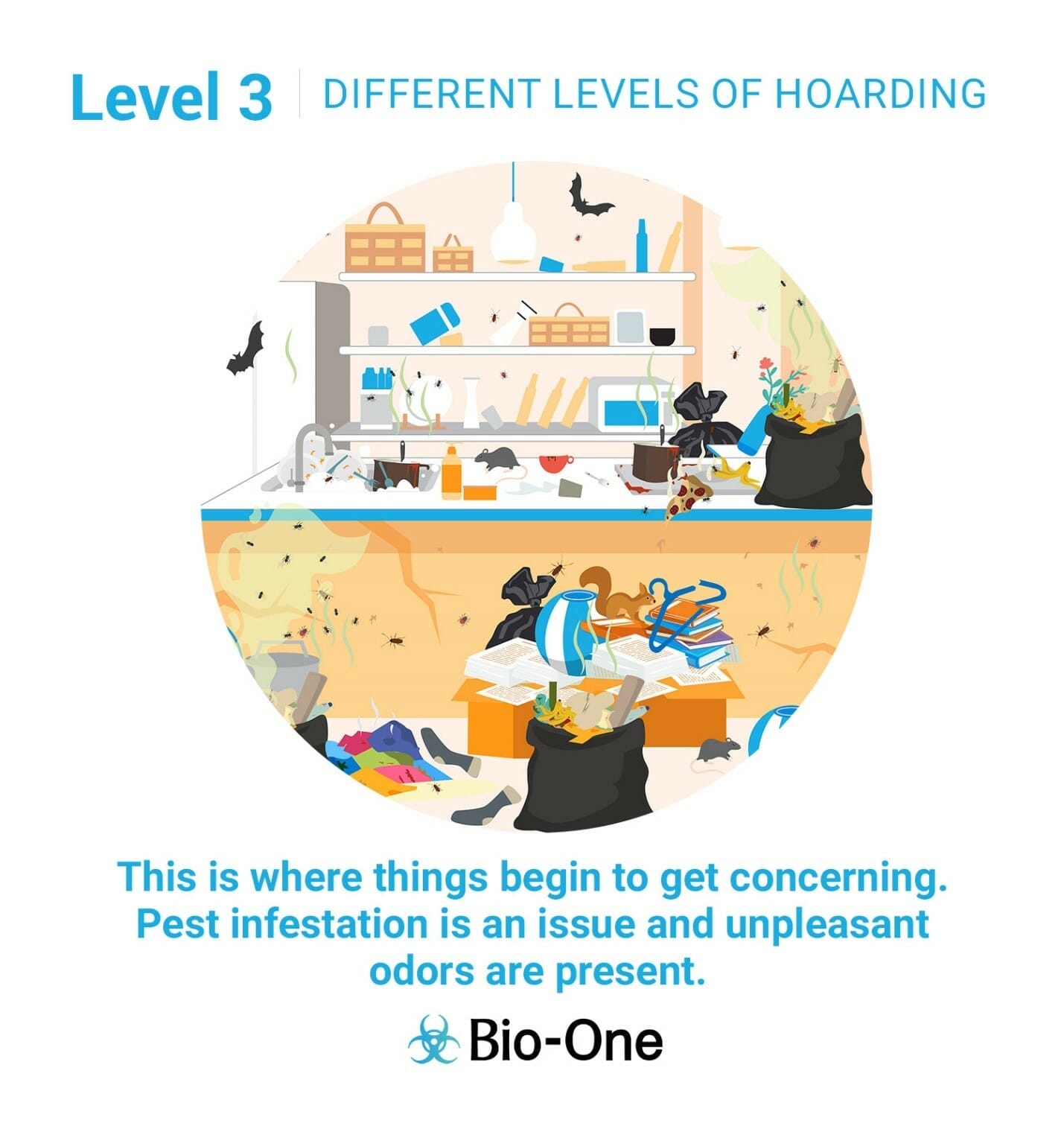
Level 3 is considered the turning point between manageable household disorganization and a more serious issue. Level 3 homes show extreme disorganization and indicate hoarding behavior.
Here are the defining characteristics of this level:
Level 3 households should consider hiring outside help. Although, it’s still possible to get it under control with a concerted effort from the whole family

At Level 4, the home shows excessive clutter.Those living in Level 4 conditions need professional help. At this level, part of getting help includes professional cleaning to transform the house into a safe, hygienic space where people can thrive. Mental health counselors and social workers may also step in to help residents change their habits.
Here are the defining characteristics of this level:
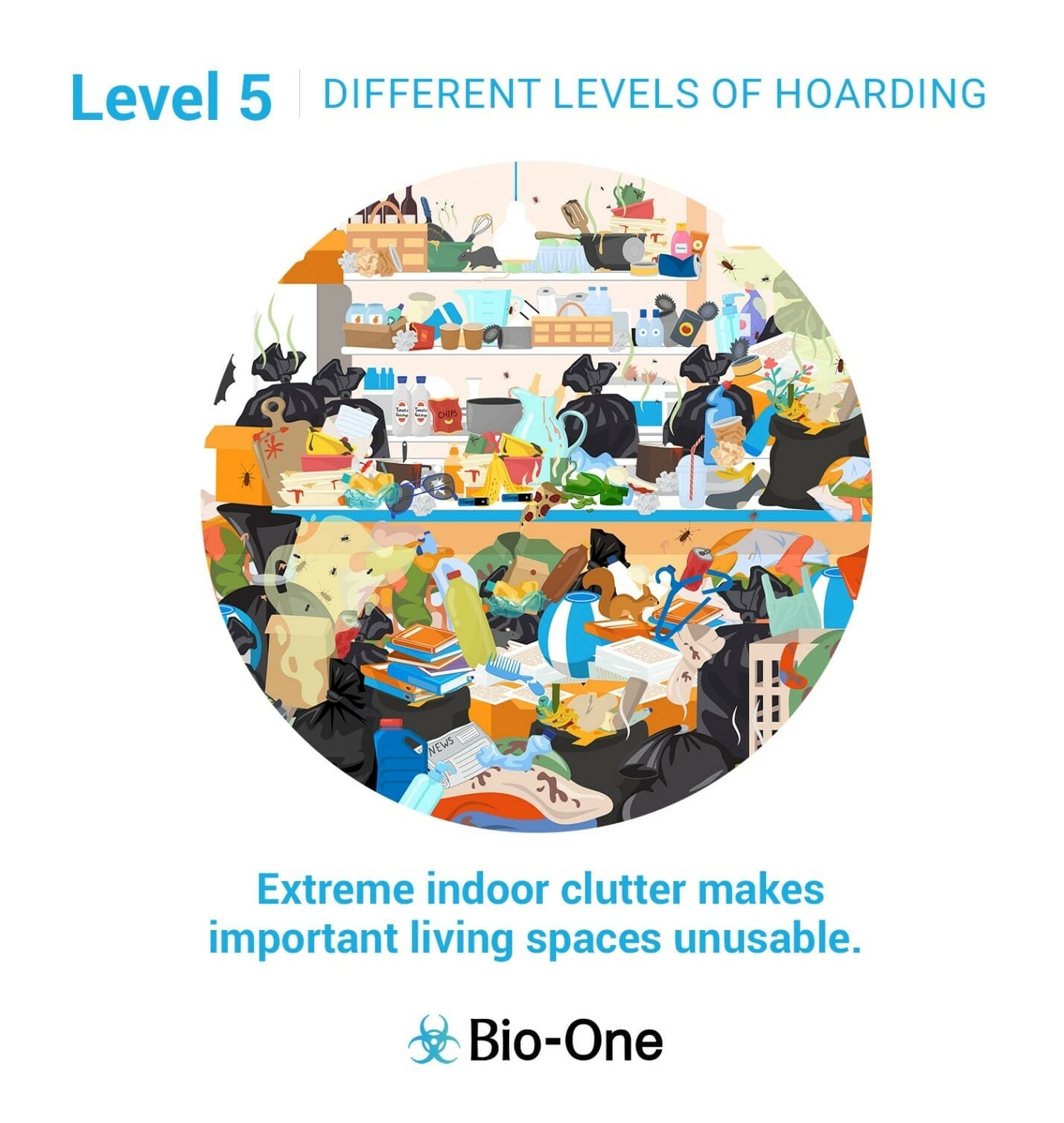
Level 5 is the highest level of hoarding behavior. Level 5 homes are alarmingly hazardous.
They require professionals with safety equipment and training to clean.
Here are the defining characteristics of this level:
If you or someone you know is struggling with these levels of hoarding we are here to help.
You can find more information at https://bioonetowson.com/ or contact us at (443) 846-2323
Clutter is an everyday occurrence and there comes a point when we all need to clean up our messes. Leave things long enough, and we all start to fall into one of the 5 levels of hoarding.
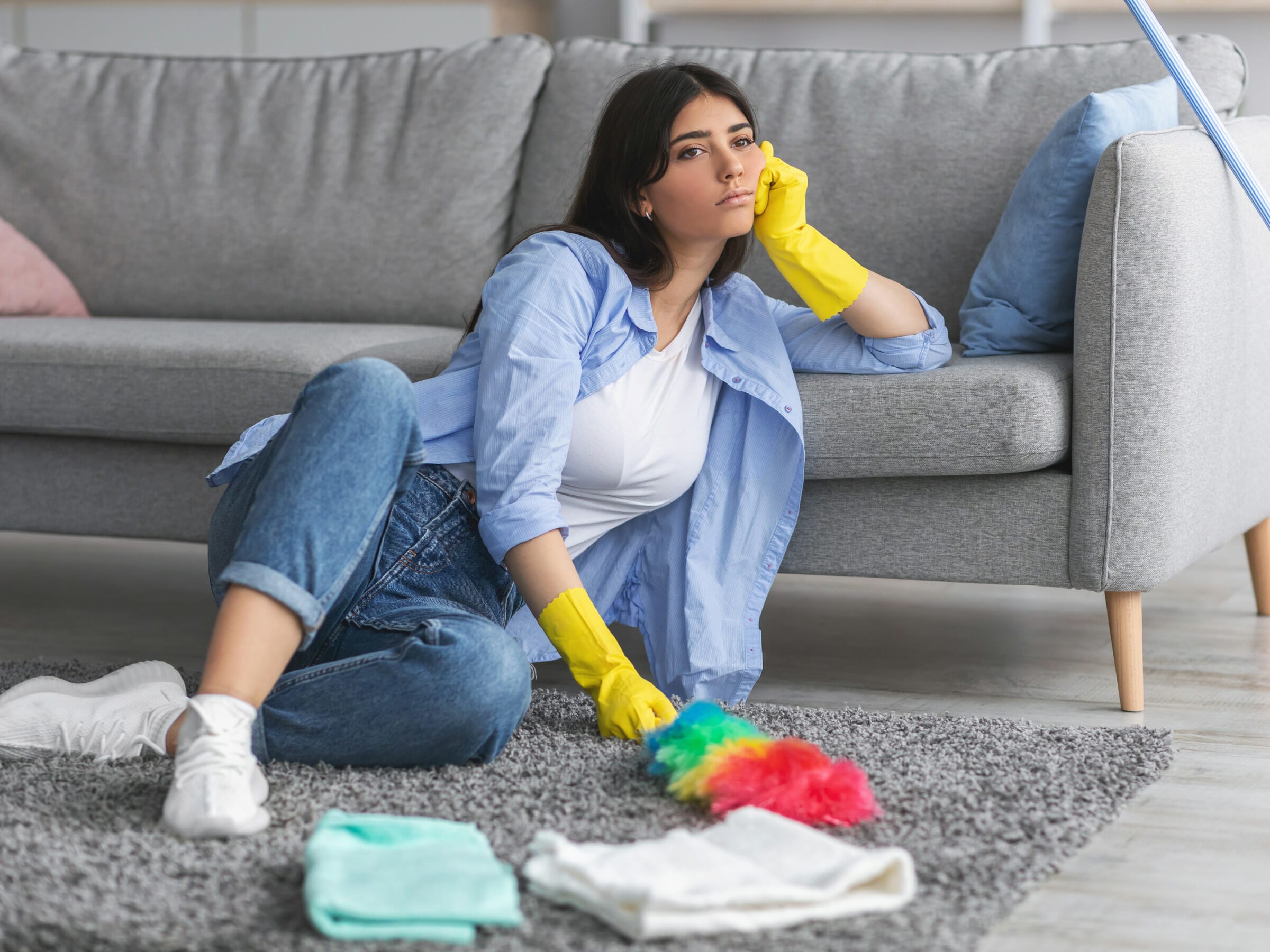
But what are the 5 levels of hoarding?
What moves a messy room from Level 2 to Level 3?
Understanding the hoarding level of your space can help you prioritize which messes are one-person tasks and which may need some help from a back-up team.
Let’s walk through each level of the Institute for Challenging Disorganization’s Clutter-Hoarding Scale to better understand just how normal hoarding is.
There’s no doubt that many of us would like our homes to look as pristine as a real estate listing ad. But life’s hectic! With busy work and family schedules, numerous responsibilities and obligations, and competing priorities it’s easy to put off a small mess for later. However those moments of procrastination stack up to put our home at a Level 1.

Signs of this level of hoarding include clutter and messes that do not threaten your safety:
Ok, that last one MIGHT be dangerous if you’re barefoot.
None of these messes block exits in your home, and they do not cause an immediate bad odor. If we’re honest, we can admit that all of us—at one point or another—have had our home come in on this level of the hoarding scale.
Leaving your house in this state does not necessarily affect your health.
However, it may exacerbate avoidance habits that lead to snacking and more procrastination—which might lead to more clutter, shifting you up the scale.
This is another common level of hoarding. Most of us frequently bounce between Level 1’s clutter and Level 2’s disarray.
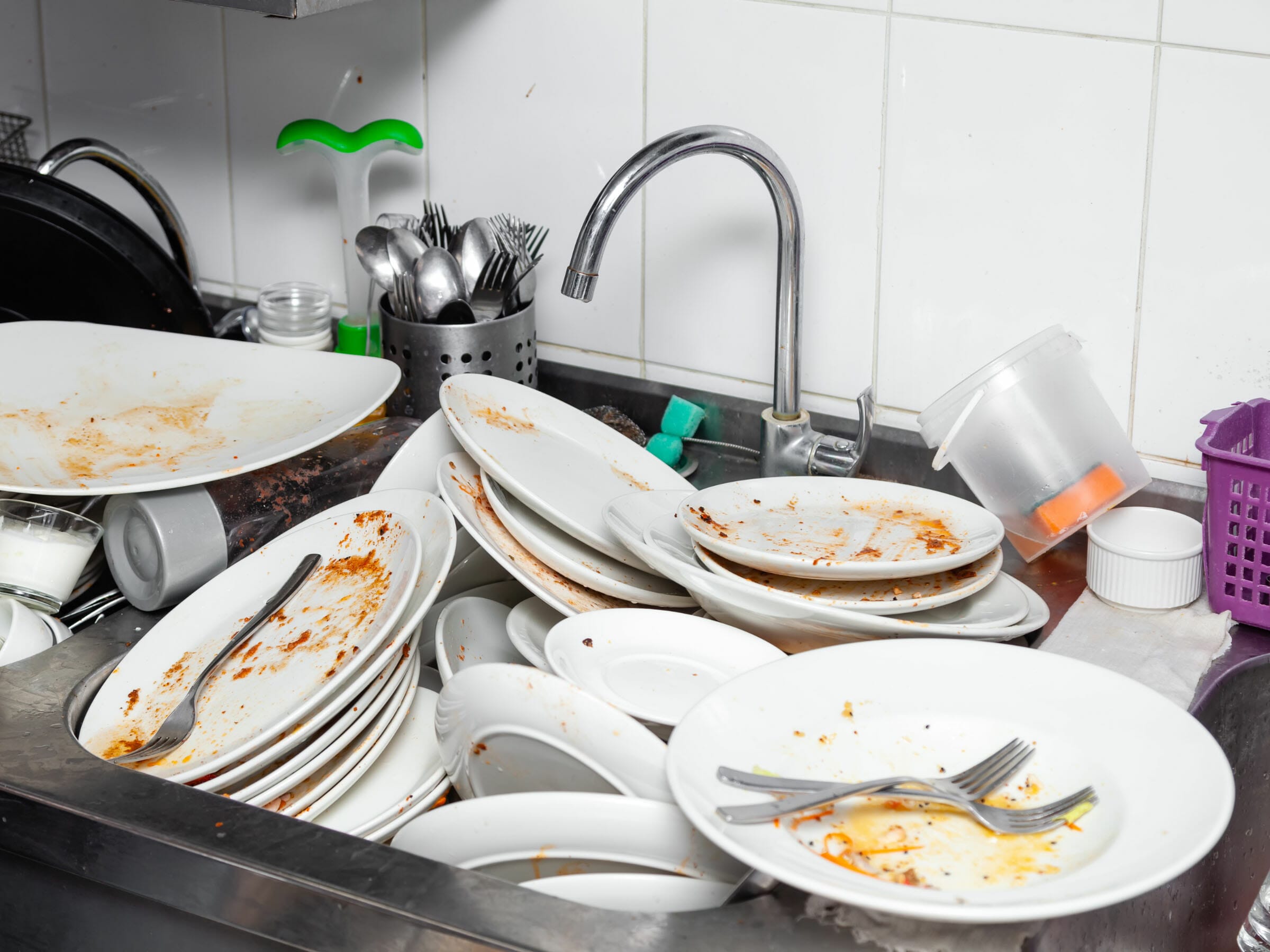
At this level, things literally begin to stack up:
At Level 2, the clutter can begin to impact a variety of areas of our lives. Some studies claim intense clutter increases our stress, makes allergies worse, and overall causes us to feel less satisfied with life.
These negative impacts are sometimes the trigger that leads to the situation getting worse.
Level 3 is where things begin to get concerning.

At this point, the mess itself may seem too daunting to tackle, and the increase in clutter results in a decline of cleanliness. There may be piles of objects obstructing multiple exits—or even a whole room used for storage instead of living.
It’s at this stage that pest infestations may become an issue. With the clutter, there are lots of places for unwelcome pests to hide and find food, and infestations of ants, lice, and cockroaches may warrant an exterminator. However, all that clutter makes it difficult for the exterminator to do a good job. Unfortunately, failing to clean up the source may set the stage for another infestation within a few weeks.
Another area of concern may be repairs needed around the home. Work may need to be done, but technicians or repair personnel may not be able to physically get to whatever needs to be fixed. This means small problems may become large ones as minor repairs are left to turn into bigger problems.
This state of things deeply impacts your ability to socialize. Messy and infested living spaces make it difficult to relax with your partner or family. Friends may prefer to outright avoid hangouts at your home. Your loved ones may be concerned about your living situation at this point.
The longer your home sits at Level 3, the higher the chance that leftover messes become long-term damage.
Hygiene and safety take a backseat in a house at Level 4. Long-term spills and messes create bad smells, and much of the house cannot be adequately used for each room’s purpose.
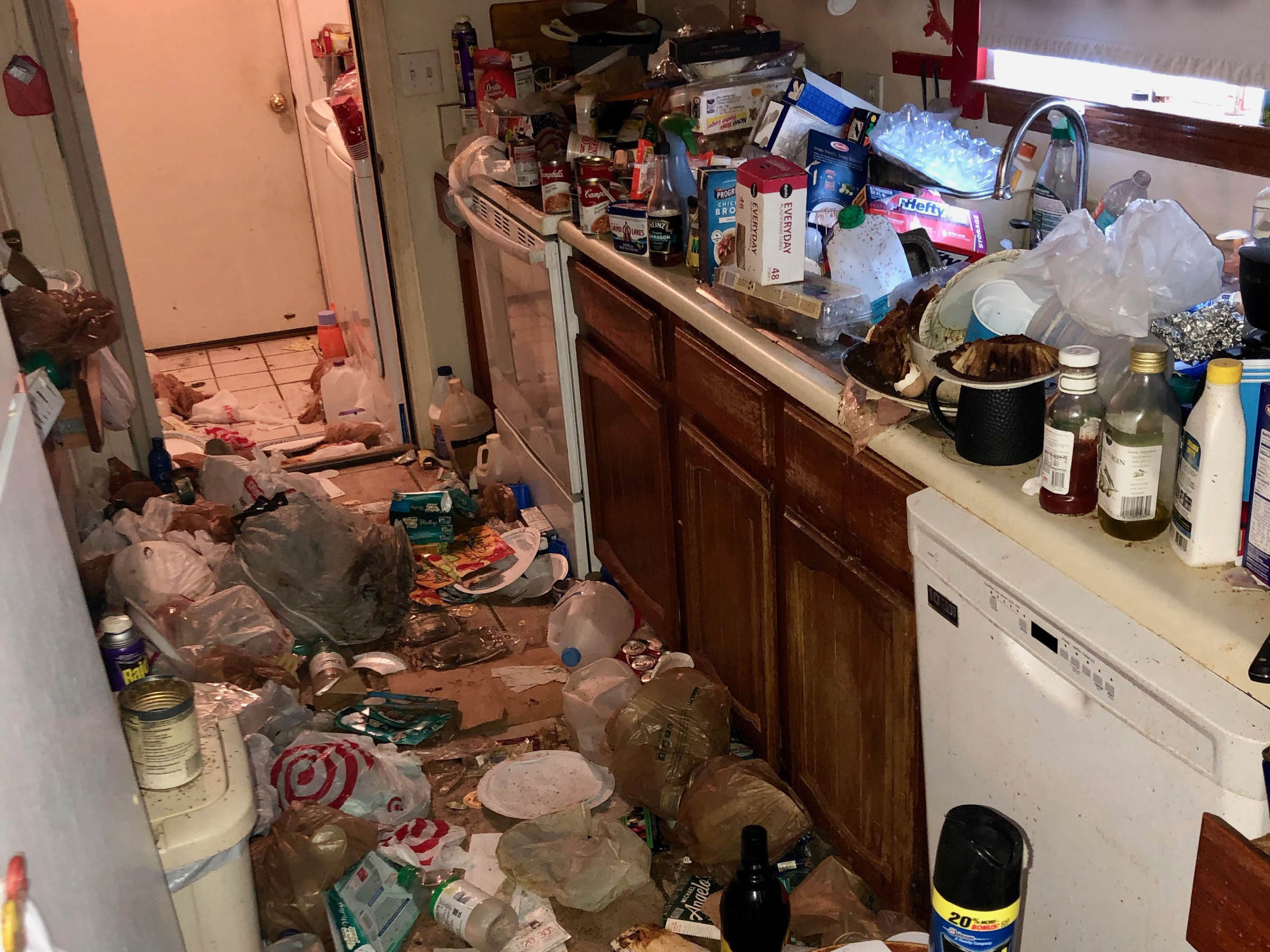
Those whose homes fit this category face daily irritation and inconvenience, all of it eventually leading to high repair bills, tripping hazards, and health hazards.
You may not think tripping hazards are a big deal, but falling over them certainly can be. Depending on how high the stacks are, they could even fall on you and do some damage that way.
There have been well documented cases where people have become trapped in their own home due to tripping hazards. Don’t let that be you!
Health hazards stack up in level 4 almost as quick as the clutter does. Issues like water damage that can no longer be reached lead to structural decay. Larger pests like bats or rodents may make their nests in the attic or basement and contribute to higher possibilities of disease.
A person or family living in this state may find it difficult to be comfortable doing anything.
Tackling the job to get the home back to a healthy and safe state may seem impossible on their own.
This is often what people think of when discussing hoarding behaviors. The situation may be the result of a psychological hoarding disorder or difficulty due to disability. It may have been compounded by depression or generational trauma or habits. The contributing factors are nuanced, varied, and often highly personal.
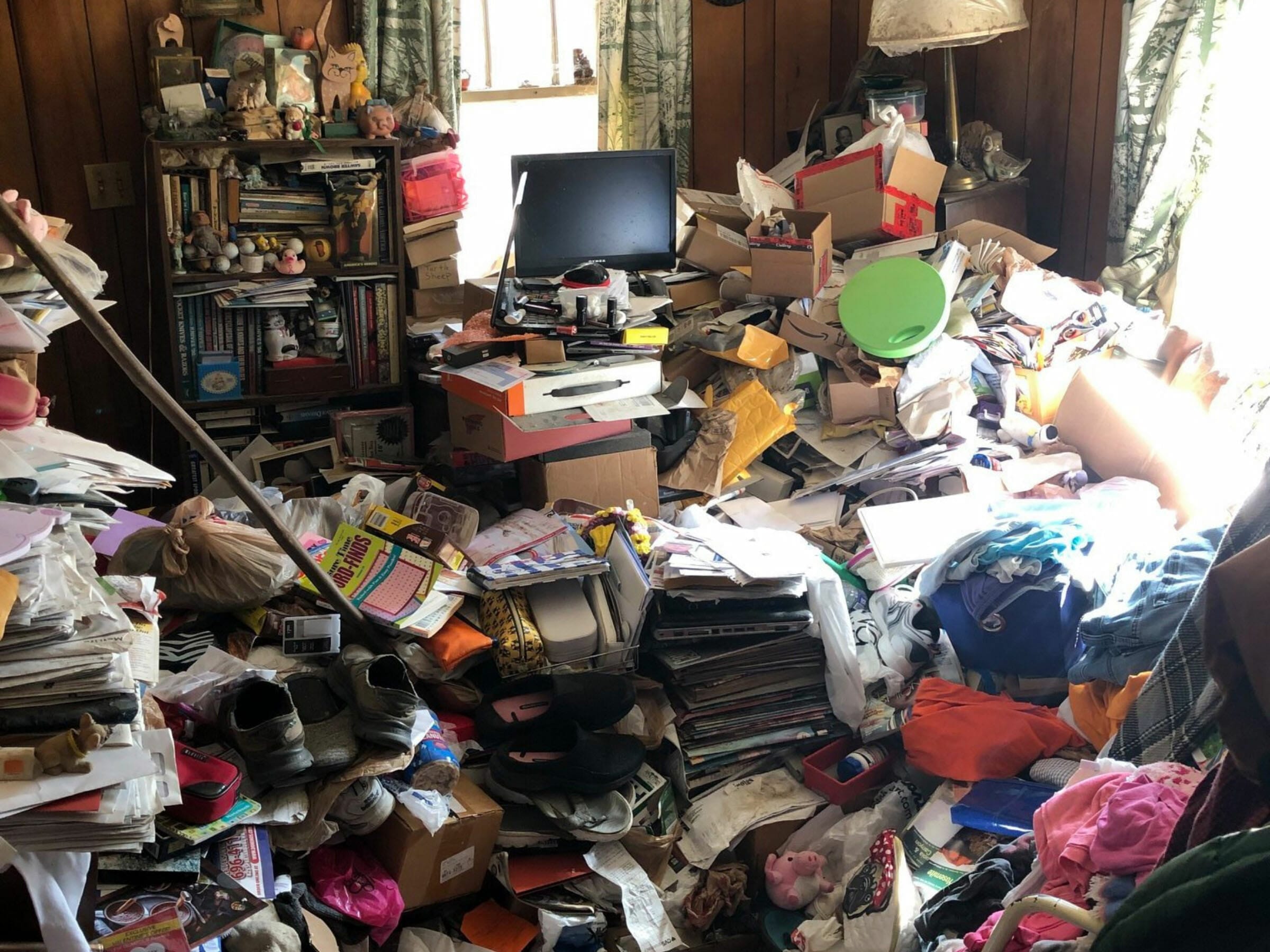
But whatever the reason, a Level 5 household is in need of serious, professional help.
Those in a Level 5 house live in outright unsafe conditions. On the daily they are coming in contact with:
Not only is it difficult to socialize with others in your home, you may find it difficult to even leave because of the sheer volume of things in the home and the blocked entryways.
Many who are at this stage find themselves disconnected from reality in a number of ways:
At this stage, the structural damage to the home is often irreparable and fire hazards begin to enter the picture.
Houses at level 5 are prone to fires because of the flammable piles of clutter. If a flame were to spark anywhere, it could easily catch something and spread from there.
Not only that, but it’s very difficult for firefighters to enter. If a fire were to start there’d be little to no way of stopping it. With so many flammable objects and no way to enter the home, all it can do is burn.
So how did your home do? Do you have an idea of where your home fits on the hoarding scale? The vast majority of us are on there somewhere, and the good news is that no matter the level your home scores, there is always help available.

After walking through all 5 levels of hoarding, it’s clear we all struggle with cleaning up the house sometimes. There’s nothing wrong with a messy house. It’s a part of normal, everyday life.
However, your health and safety are important, particularly when things advance to those higher levels. When facing a daunting clean-up, here’s quick tip for each level of hoarding:
Your home falls into one of these levels—just like everyone else’s! The next step is determining what you need to get back to a manageable Level 1.
Our team at Bio-One understands messy homes, and we’re here to offer discreet, compassionate help when you or a loved one is trying to dig out from a higher level mess. We offer affordable, professional services that include cleanup, disinfection, and decontamination.
Every job has a unique remediation plan tailored to the specific needs and goals of the client. Rest assured, wherever you may fall on the levels of hoarding, we have the experience and equipment necessary to help you.
Consult with our team today to discuss your situation and determine how much time you can save with professional help.

Bio-One teams across the U.S. answer calls to help their communities and remediate a variety of scenes. In our new blog series, we'd like to bring you into the Bio-One world by sharing stories of the unique and important work we do for local communities.
Here is Week 5 of our Bio-One Weekly Wrap-Up.
Chocolate Spill Makes for a Sweet Cleanup
In Scranton on March 25, Juan and Nicole Morales received a call for a "chocolate" cleanup. Assuming this was code for a sewage back-up, they rushed to scene to find a different situation entirely. Approximately 100 gallons of milk chocolate had spilled, covering asphalt outside a local business.
This is certainly the sweetest smelling job a Bio-One office has ever taken, but Nicole clarified, "That smell was nice for the first few minutes but at the end I felt sick. Good thing we had an awesome team that pushed through and got this done!"
After scraping the chocolate with a forklift and pressure washing the area, the Bio-One team received a five-star review. Well done!


Behind the Scenes with Citizen's Academy
Many Bio-One owners sign up for their local Citizen's Police Academy to acquaint themselves with the activities of their local police department. This week, Bio-One owner, Ginger Akemon, in Jacksonville, FL earned her Citizen's Police Academy certificate from the Clay County Sheriff's Office.
"Definitely a learning process. Each County has their own, my goal is to go to each county's classes. This was 10 weeks long and over an hour drive each way, but well worth it, " said Ginger.
Hoarding Transformation in Long Beach
In Long Beach, the Bio-One team has been working hard on several hoarding projects. These before and after pictures show the detail and expertise our teams bring to each job.

Bio-One teams across the U.S. answer calls to help their communities and remediate a variety of scenes. In our new blog series, we'd like to bring you into the Bio-One world by sharing stories of the unique and important work we do for local communities.
Here is Week 4 of our Bio-One Weekly Wrap-Up.
New Start for New Haven Veteran
In New Haven County, Bio-One and Junkluggers answered the call to help a veteran and his disabled wife. The couple were overwhelmed with a hoarded home and much of their furniture would need to be disposed due to biohazardous conditions. With Bio-One's Help First, Business Second motto in mind, Bio-One owner, Matthew Hill, teamed up with Junkluggers to re-furnish the home with gently used furniture at no cost to the client.
“Anytime we can give a little more to our clients, we always seize the opportunity,” said Hill. “Junkluggers has been an awesome organization with a great mission that fits nicely into what we are trying to accomplish.”

#HelpFirst for Heart-Breaking Scene
In South Carolina, Bio-One owner, Kris Elliott, was called to disinfect and clean a heart-breaking trauma scene. After hearing the family's story, he generously decided not to request payment for his services and shared their GoFundMe page on Facebook. As of March 20, Bio-One offices in North Carolina and South Carolina have contributed just under half of the total donations. This is #helpfirst at it's finest.
If you'd like to learn more about the family and donate, please visit their GoFundMe page.
Poker Run Supports Law Enforcement
Supporting local law enforcement is a 24/7 activity at Bio-One! In Tuscon, AZ, the Bio-One team participated in the South Arizona Law Enforcement Foundation (SALEF) poker run. SALEF collaborates with law enforcement to understand their greatest needs, and work with businesses in the community to raise money by presenting community events and submitting for grants.
Looks like they were gifted a beautiful day for cards, corn hole, and backing the blue.

Bio-One teams across the U.S. answer calls to help their communities and remediate a variety of scenes. In our new blog series, we'd like to bring you into the Bio-One world by sharing stories of the unique and important work we do for local communities.
Here is Week 3 of our Bio-One Weekly Wrap-Up.
Five 30 Yard Dumpsters
The team in Pensacola has been working non-stop on a two story home that required Bio-One hoarding services. Over the course of five days, they filled five 30 yard dumpsters, and found multiple antique pieces, photographs, sentimental items and cash that was promptly turned over to the client.
Look through the transformation photos on their Facebook page!
Backing the Blue in Omaha
The Bio-One team in Omaha dropped off bagels at the Omaha Police Department just before roll call, and Vanessa Urbach, the civilian crime and prevention specialist, tweeted a "Thank You" with shoutouts to Bio-One. Joining the conversation was our own Bio-One Twitter handle, Deputy Chief Ken Kanger, host of the What's Up Omaha Podcast, and a number of other officers in the department.
Kudos to the Omaha team for backing the blue!
Safety First
Before Bio-One teams can help first, we have to ensure safety for every technician on the job site. This week, Bio-One owners took part in conversations about safety. Topics ranged from preventing common injuries on the job to attending OSHA training with Bob Easter. Jared Lafferty, Bio-One owner in Gwinnett County, even took the conversation to Twitter and featured safety protocols his team uses while on the job.
We couldn't be prouder of our teams for putting safety first!

Bio-One teams across the U.S. answer calls to help their communities and remediate a variety of scenes. In our new blog series, we'd like to bring you into the Bio-One world by sharing stories of the unique and important work we do for local communities.
Here is Week 2 of our Bio-One Weekly Wrap-Up.
14,000 lbs of Clothing Removed from Hoarded Home
In Indiana, the Marion County team remediated over 30+ years of hoarded clothes in a home. The team calculated that approximately 14,000 lbs of clothing were removed.
Bio-One’s teams know that every job represents a unique experience for our customers, who may have difficulty parting with deeply personal items that can range from clothing, video tapes, trash, and even animals.
Read our recent blog post answering common questions about animal hoarding.
We work with all of our clients in a step-by-step process that instills trust while properly ridding the space of items that can prove harmful. Learn more about Bio-One's hoarding services.
Bio-One Welcomes Two New Offices in Wisconsin
Two Bio-One offices launched in Wisconsin this week, and we are very excited to welcome Angela, David, Andrew, and Viktoriya to the Bio-One family. Learn about these amazing teams below!

Madison, WI
Angela Welbes and David Levin are the owners of Bio-One of Madison. Both were born and raised in the midwest, and they met in 2015 while they were both living in Wisconsin. Their blended family consists of 3 daughters and a son. The COVID pandemic provided a personal reset that enabled an opportunity to join the growing Bio-One family and the ability to help the surrounding communities of Madison. They are excited to start this new venture together.

Milwaukee, WI
Andrew and Viktoriya Gonzales are the owners of Bio-One of Milwaukee. Andrew spent the last 24 years in the banking industry, in addition to serving on boards and committees for several Non-Profits, such as NAMI, Madison Development Corp and United Way. Viktoriya originally came to Wisconsin 16 years ago to further her education and loved it so much, she decided to stay. She has spent the last 12 years in telecommunications and management. Both have a passion for giving back to their community and have a drive to help those in the Milwaukee and surrounding area who are in need.
COVID-19 Disinfections Help Seniors in Charlotte, NC
This week, the Bio-One team in Charlotte, NC announced the renewal of a COVID-19 disinfection partnership with the Mecklenburg County Department of Social Services. This unique #HelpfFrst service offers free disinfections to seniors, 60 years of age or older. See their Facebook post below to learn more.